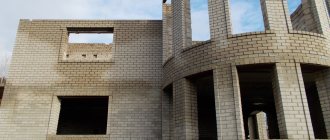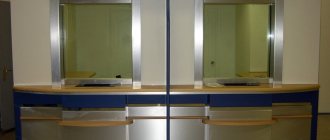Accounting in construction has its own individual characteristics. Carrying out accounting requires special industry knowledge of the accountant and practical experience. Accounting in construction is carried out on the basis of current legal acts that regulate: the procedure for investing funds, the procedure for accounting for contract agreements and other provisions. General requirements for accounting allow you to correctly calculate the company's income and expenses. Depending on the specifics of the industry, additional regulatory sources may apply.
Contractor accounting
Accounting is carried out on the basis of the following regulations: PBU 9/99, PBU 10/99, PBU 2/94, PBU. The entire cost part is subject to division into the elements listed above. Construction costs are displayed in accordance with accounting account 20 “Main production”. Costs for materials, payments to employees are recorded, and settlements with suppliers are additionally displayed. Phased acceptance is carried out using account 46, with the formation of posting Dt 46 Kt 90.
Accounting: cost reflection
In accounting, all costs associated with the construction (manufacturing) of an object (the cost of the contractor’s work, materials consumed, equipment transferred for installation at the site, etc.) are reflected in account 08-3 “Construction of fixed assets”. In this case, make the following entries:
Debit 08-3 Credit 60 (76)
– the cost of contract work for the construction of fixed assets is reflected (based on forms No. KS-2 and No. KS-3);
Debit 08-3 Credit 07
– reflects the cost of equipment transferred for installation to the contractor in the facility under construction;
Debit 08-3 Credit 23 (25, 26, 70, 76...)
– reflect other costs associated with bringing the object to a state suitable for use;
Debit 19 Credit 60 (76)
– VAT charged by the contractor is reflected, as well as on other costs associated with the creation of a fixed asset.
Situation: how to reflect the cost of construction work performed by a contractor in accounting? The construction contract provides for phased delivery of work.
The construction contract may provide for phased delivery of work (Articles 740 and 753 of the Civil Code of the Russian Federation). This means that as each stage is completed, the organization and the contractor must sign an act in form No. KS-2 and a certificate in form No. KS-3. Such rules follow from the instructions approved by Resolution of the State Statistics Committee of Russia dated November 11, 1999 No. 100.
At the moment when the act is signed, include the cost of the completed stage in the capital investments for the construction (manufacturing) of the fixed asset. That is, take into account account 08 “Investments in non-current assets”. This follows from the Instructions for the chart of accounts.
At this moment (subject to other conditions required for deduction), the input VAT presented by the contractor upon completion of this stage can be deducted (clauses 1 and 6 of Article 171, clauses 1 and 5 of Article 172 of the Tax Code of the Russian Federation, letters from the Ministry of Finance Russia dated March 5, 2009 No. 03-07-11/52, dated February 19, 2007 No. 03-07-10/06).
Include the finished object in fixed assets upon completion of the last stage of construction (manufacturing) (Instructions for the chart of accounts). In this case, draw up an act in form No. OS-1a (OS-1, OS-1b) (Part 1 of Article 9 of Law No. 402-FZ of December 6, 2011, instructions approved by the Resolution of the State Statistics Committee of Russia of January 21, 2003. No. 7).
Situation: how to reflect in accounting the cost of own materials transferred to the contractor for the construction (manufacturing) of a fixed asset?
In accounting, the cost of materials purchased for use in the construction (manufacturing) of a fixed asset is included in its initial cost. In this case, only those materials that are actually used can be included in the initial cost. This procedure follows from paragraph 8 of PBU 6/01.
The mere transfer of materials to the contractor does not mean that all of them were used in construction. Therefore, it is impossible to include the cost of all transferred materials in the initial cost of the object. You need to know how much materials were actually consumed. This information may be reflected in the contractor's report. There is no standard template for such a report, so it can be compiled in any form. The main thing is that it contains the mandatory details specified in Part 2 of Article 9 of the Law of December 6, 2011 No. 402-FZ. The contractor's obligation to prepare such reports, as well as the frequency of their submission, should be stipulated in the contract. The right to demand the organization’s reports from the contractor is given by Part 1 of Article 748 of the Civil Code of the Russian Federation, according to which the customer can control, among other things, the contractor’s use of the materials transferred to him.
In accounting, the receipt of materials purchased for use in construction (manufacturing) is reflected in account 10-8 “Building materials”. When transferring materials to the contractor, transfer their cost to account 10-7 “Materials transferred for external processing”:
Debit 10-7 Credit 10-8
– reflects the cost of materials transferred to the contractor for the construction of the facility.
This procedure is provided for in paragraph 157 of the Methodological Instructions, approved by Order of the Ministry of Finance of Russia dated December 28, 2001 No. 119n.
After the contractor submits a report on the materials used, include their cost in the costs that form the initial cost of the facility under construction:
Debit 08-3 Credit 10-7
– reflects the cost of materials spent on the construction of the facility.
This procedure is provided for in the Instructions for the chart of accounts.
Situation: how can a developer reflect in accounting the transfer of an unfinished construction project to conservation?
The decision to mothball an unfinished facility is made by the head of the organization (which is the construction developer). It is formalized by an order (instruction) in any form. In this document, indicate the time frame within which the documentation necessary to carry out the work and ensure the safety of equipment, structures and materials at the site will be prepared. An order for the conservation of an unfinished construction object is issued in the same way as an order for the conservation of a fixed asset object. Notify the contractor of your decision.
During conservation, an inventory of unfinished construction is carried out (clause 26 of the Regulations on Accounting and Reporting). The procedure for its implementation is established by paragraphs 3.32–3.35 of the Methodological Instructions, approved by Order of the Ministry of Finance of Russia dated June 13, 1995 No. 49. For unfinished capital construction, the inventories indicate the name of the object and the volume of work performed on this object, for each individual type of work, structural elements, equipment, etc. Inventory is carried out through control measurements. At the same time, the actual volumes of construction and installation work performed must be compared with the data of local estimates, as well as with the accounting data of the developer and contractor. After the inventory, the developer accepts from the contractor mothballed objects, as well as material assets that the contractor cannot use in the construction of other objects. For more information on conducting an inventory, see How to conduct an inventory.
After this, the parties must sign:
- estimates for work related to conservation and construction safety;
- act on suspension of construction in form No. KS-17 (approved by Resolution of the State Statistics Committee of Russia dated November 11, 1999 No. 100).
This procedure is confirmed by the letter of the USSR State Construction Committee dated August 18, 1986 No. 61-D.
A design organization is engaged to develop an estimate for the conservation and protection of a construction site. According to this estimate, the contractor performs construction and installation work on the basis of an additional agreement to the general contract. The developer pays the contractor for all work performed and costs associated with conservation. These rules follow from the provisions of Articles 452, 740, 752 of the Civil Code of the Russian Federation, paragraph 17.10 of the Methodological Recommendations, approved by Protocol No. 12 of January 5, 1999.
The costs associated with the conservation of an unfinished construction project, including the costs of its maintenance, should not be included in the cost of construction. Such costs in accounting form other expenses of the customer (clause 14 of PBU 2/2008). Reflect them on account 91 “Other income and expenses”. This procedure follows from paragraph 11 of PBU 10/99, Instructions for the chart of accounts (account 91) and letter of the Ministry of Finance of Russia dated January 13, 2003 No. 16-00-14/7.
In accounting, reflect this operation by posting:
Debit 91-2 Credit 10 (23, 60, 68, 69, 70...)
– the costs of conservation and maintenance of mothballed property are taken into account.
For the convenience of tracking information about the condition of the property for account 08, open a separate sub-account - “Objects of unfinished construction under conservation.” This approach is consistent with the Instructions for the chart of accounts (account 08).
Reflect the transfer to mothballing of an unfinished construction project by posting:
Debit 08 subaccount “Unfinished construction objects under conservation” Credit 08 subaccount “Construction of fixed assets”
– an unfinished construction site was transferred for conservation.
An example of reflecting the costs of conservation of an unfinished construction project in a developer’s accounting
Last year, Alpha LLC (developer) entered into an agreement with Proizvodstvennaya LLC (contractor) for the construction of an office for a period of two years. This year, construction has been stopped due to a lack of funds to cover costs. At the time of construction termination, the total cost of the work performed was RUB 1,852,000.
For the development of an estimate for the conservation of the facility, Alpha paid the design organization 11,800 rubles. (including VAT (18%) - 1800 rubles).
An additional agreement was concluded with “Master” to carry out conservation work. The “Master’s” expenses for these works amounted to 118,000 rubles. (including VAT (18%) - 18,000 rubles). Alfa bears monthly expenses for the maintenance of the mothballed facility in the amount of 50,000 rubles. (watchman's salary including insurance premiums).
To make it easier to track information about the condition of property, Alpha’s accountant opened separate sub-accounts for account 08:
- “Object of unfinished construction under conservation”;
- "Construction of fixed assets."
This year, the accountant made the following entries in the accounts:
Debit 08 subaccount “Object of construction in progress” Credit 08 “Construction of fixed assets” – 1,852,000 rubles. – the unfinished office building was transferred for conservation;
Debit 91-2 Credit 60 – 10,000 rub. (RUB 11,800 – RUB 1,800) – reflects the costs of preparing estimate documentation for the conservation of the office building;
Debit 19 Credit 60 – 1800 rub. – VAT is taken into account on the amount of costs for preparing estimate documentation;
Debit 91-2 Credit 60 – 100,000 rub. (RUB 118,000 – RUB 18,000) – reflects the costs of paying the contractor for the conservation of the office building;
Debit 19 Credit 60 – 18,000 rub. – VAT is taken into account on the cost of the contractor’s work on conservation of construction;
Debit 60 Credit 51 – 129,800 rub. (RUB 11,800 + RUB 118,000) – bills of the design organization and contractor have been paid;
Debit 91-2 Credit 70 (69) – 50,000 rub. – the salaries of the guards guarding the mothballed facility were accrued, as well as contributions for compulsory pension (social, medical) insurance and contributions for insurance against accidents and occupational diseases from it.
Accounting in a construction organization
Accounting is somewhat different from the norms in force for other business entities. The differences lie in the documentation. To carry out mutual settlements with contractors, construction organizations use the following documents:
- Form No. KS-2;
- Form No. KS-3.
Form 2 is drawn up by the contractor based on the results of the work performed. Form 3 is the basis for mutual settlements between the customer and the contractor. The first document can be drawn up upon completion of the entire scope of construction or taking into account the phased implementation of work. The last option is most preferable for contractors.
Procedure for creating an OS
The process of construction or creation can be carried out in two ways - economic or contracting. The first involves the use of one’s own forces and resources, the second involves turning to third-party specialized persons. Accounting for the economic method of constructing OS.
Accounting for construction or manufacturing costs is carried out differently in both methods. The costs will be different, but the principle of forming the initial cost of the final OS object will be the same for both methods. This indicator will be collected from the sum of all expenses incurred.
Postings for specific construction expenses
The status of the customer and his investments in construction determine the accounting plan. Postings for specific construction expenses are made as follows:
- The operation of the company transferring materials and equipment to the contractor in an amount over 20,000 rubles is reflected in the section “Contributions to non-current assets” (debit 08) and in the section “Settlements with suppliers and contractors” (credit 60).
- If the amount is less than 20,000 rubles, the action is carried out through “Materials” (debit 10) and “Settlements with suppliers” (credit 60).
- The fact of the initial operation of the object is recorded through “Fixed capital” and “Contribution to non-current assets”.
- To write off building materials, use the “List of Written Off Materials”.
- Percentage tax surcharges are displayed in the “VAT” section, indicating the amount in a special separate cell.
- After completion of the construction process, state registration of the object is carried out and data is entered into the “Fixed Capital”.
All of the above rules apply to accounting for the customer construction company.
Postings from the contractor are drawn up in accordance with debit 20 “Main production”, which will subsequently correlate with credit 60 (payment for supplies), credit 70 (settlements with employees) and credit 10 (inventories).
During phased construction, the customer accepts the results of the work at each stage. In this case, debit 46 is combined with credit 90.
Carrying out accounting operations requires highly qualified accountants. Quite often, companies invite highly specialized specialists to fill this position.
VAT accounting
Value added tax can be separated from the cost of contractors' services and sent for deduction, while this is reflected in accounting using the entries: D19 K60 and D68 K19.
If a company transfers its own material assets to the contractor for construction, then VAT on these inventories can also be deducted - this is done upon receipt of such materials upon receipt of an invoice from the supplier.
It is possible to deduct VAT under the contract method regardless of the activity in which the constructed fixed asset will be used - subject to VAT or not.
Depreciation on the created fixed asset must be calculated from the next month. If we are talking about the construction of an operating system, then depreciation is calculated from the 1st day of the following month after the moment of submission of papers on state registration of the right to the constructed object.
Taxation in construction
Keeping tax records in construction allows you to create and summarize information that will allow you to determine the tax base based on primary documentation data. The goals are the following: generating reliable information, ensuring control of the completeness and correctness of calculations for subsequent payment to the budget.
The basic principles of taxation in construction are the economic justification of expenses and their documentary justification. Taxation in construction should be compiled in such a way that the information makes clear the following nuances:
- methods for determining income and expenses;
- algorithms for the formation of tax bases;
- the methods used to form reserves;
- methods of temporary distribution of expenses;
- mechanisms for transferring part of expenses to subsequent periods;
- formation of other tax parameters.
The activities of construction organizations are carried out in accordance with current tax legislation. Regulatory documents contain provisions that take into account the specifics of construction activities.
Income tax does not include expenses for the acquisition of depreciable property, expenses for modernization and technical re-equipment of the facility. Income tax is not calculated in the case of additional work to restore the property.
Amounts saved during construction work are subject to income tax as non-operating income. Accounting is carried out for both direct and indirect expenses of the company. The customer independently determines the list of funds spent related to the provision of services and the procedure for their distribution. The result is necessarily recorded in the tax accounting policy of the enterprise.
Individual characteristics of the construction process
Despite the fact that accounting in construction in the Russian Federation is carried out on the basis of general requirements and regulations, it is characterized by a large number of individual features. The reason for the presence of these features is the specifics of the construction process. For this article, we will highlight the following as the main individual characteristics of the construction site:
- Duration of execution of contract agreements. As a result, the start of work and its completion usually belong to different reporting (including tax) periods.
- The following feature follows from the atypical duration of the work cycle: phasing. Both delivery to the customer and payment by the customer usually take place in several stages. This leads to specificity in the formation of revenue and cost.
- With regard to the formation of cost in construction, there are also a number of special techniques and methods. The main purpose of these methods is, if possible, to compensate for the uncertainty in the reliability of the assessment of the financial result of the construction project being taken into account. On the one hand, based on accounting principles, receiving advances from construction customers does not provide sufficient confidence that revenue can be determined on the basis of these advances. On the other hand, the planned cost indicators determined during the work also cannot be considered completely suitable values for taking them into account in expenses when forming the financial result.
Let us examine in more detail the accounting features arising from the above aspects.
Program "BIT.CONSTRUCTION"
The BIT.CONSTRUCTION program is used to automate the tasks of all departments of a construction company. The program allows you to conduct prompt and reliable reporting on objects. The BIT.CONSTRUCTION program allows you to:
- calculate workers' salaries for each facility;
- manage financial flows, consolidate, maintain management accounting;
- maintain accounting records for contractors and customer-developers;
- automate the work of supply departments;
- systematize the work of sales departments;
- automate control processes for construction machines and mechanisms.
The BIT.CONSTRUCTION system is distinguished by its modular architecture. Each module is designed to solve a specific industry problem. The program includes several automated systems and includes comprehensive solutions for customers, contractors, supply department employees, foremen, accountants, etc. The selection of a line module is made by the customer depending on the goals and objectives set.
Documenting
Determine the amount of expenses that form the initial cost of the object based on:
- primary accounting documents used in construction (act of acceptance of work performed in form No. KS-2, certificate of the cost of work performed and expenses in form No. KS-3, etc.);
- other primary documents confirming the costs incurred (customs declarations, business trip orders, etc.).
For registration, accept documents that contain the mandatory details provided for in Part 2 of Article 9 of the Law of December 6, 2011 No. 402-FZ.
To accept the created fixed assets, the organization should create a commission, which should determine:
- whether the fixed asset meets the technical specifications and whether it can be put into operation;
- whether it is necessary to bring (rework) the fixed asset to a state suitable for use.
If the organization's staff consists only of a director, do not create a commission. In this case, its functions must be assumed by the director.
This procedure follows from the instructions approved by Resolution of the State Statistics Committee of Russia dated January 21, 2003 No. 7.
After examining the object, the commission must give an opinion on the possibility of its use. This conclusion is reflected in the act in form No. OS-1.
Fill out the act in form No. OS-1 when accepting the object for accounting (at the time of reflection on account 01 “Fixed Assets” or 03 “Income Investments in Material Assets”) (paragraph 2 of the instructions approved by the Decree of the State Statistics Committee of Russia dated January 21, 2003 No. 7, Part 3, Article 9 of the Law of December 6, 2011 No. 402-FZ). Draw up the report on the basis of primary accounting documents and technical documentation attached to the construction contract.
Do not fill out the details of the donating organization, which are provided at the beginning of the act, as well as the sections “Information on the condition of the fixed asset object on the date of transfer” and “Passed over”. This is explained by the fact that for the contractor the constructed facility is not a fixed asset. Consequently, he is not obliged to draw up an act in form No. OS-1 (paragraph 8 of the instructions approved by Resolution of the State Statistics Committee of Russia dated January 21, 2003 No. 7, letter of Rosstat dated March 31, 2005 No. 01-02-09/205).
In the act in form No. OS-1, indicate:
- number and date of its compilation;
- full name of the fixed asset;
- place of acceptance of the fixed asset;
- factory and assigned inventory numbers of the fixed asset;
- depreciation group number and useful life of the fixed asset;
- information about the content of precious metals and stones;
- other characteristics of the fixed asset (total area, number of floors, etc.).
In addition, the act must contain the conclusion of the acceptance committee (for example, the entry “Can be used”). The executed act is approved by the head of the organization.
If a building or structure was manufactured under a contract, when accepting it for registration, fill out an act in form No. OS-1a. When filling it out, apply the same rules as when drawing up form No. OS-1.
If, under a contract, fixed assets (a group of homogeneous fixed assets) other than buildings and structures were manufactured, when accepting them for accounting, fill out a report in form No. OS-1b. When filling it out, apply the same rules as when drawing up form No. OS-1.
This procedure follows from the instructions approved by Resolution of the State Statistics Committee of Russia dated January 21, 2003 No. 7.
Simultaneously with drawing up the act in form No. OS-1a (OS-1, OS-1b), fill out the inventory card in form No. OS-6a (OS-6) or the inventory book in form No. OS-6b (intended for small enterprises) in one copy. Prepare an inventory card (book) based on the data in the act and primary documents. In the future, enter into the card (book) information about all changes that affect the accounting of fixed assets (revaluation, modernization, disposal). Reflect this information on the basis of primary documents (for example, on the basis of the acceptance certificate for modernized fixed assets in form No. OS-3).
This procedure is provided for by the instructions approved by Resolution of the State Statistics Committee of Russia dated January 21, 2003 No. 7.
Situation: is it necessary, in addition to form No. KS-14, to also draw up form No. OS-3? The organization carried out technical re-equipment of production buildings, the acceptance committee drew up only an act in form No. KS-14.
Answer: yes, it is necessary.
Form No. KS-14 indicates that the customer accepted the work that the contractor performed for him, that is, the construction of the facility is completed. This act provides general information about who carried out the work at the site, indicates the author of the design and estimate documentation, and the cost of the order. The commission’s conclusion on the condition of the fixed asset is also given here. This conclusion can be drawn from the instructions for filling out the KS-14 form, approved by Resolution of the State Statistics Committee of Russia dated October 30, 1997 No. 71a.
Form No. OS-3 reflects other information: on the condition of objects before repairs (reconstruction, etc.), data on the costs of reconstruction or modernization. As well as the conclusion of the commission that carried out the acceptance and transfer of the fixed asset. In form No. OS-3, they record whether the restoration work has been completed and list the changes that have occurred. This follows from the instructions for filling out form No. OS-3, approved by Resolution of the State Statistics Committee of Russia dated January 21, 2003 No. 7.
Thus, Act No. OS-3 is a document on the basis of which the initial cost of a fixed asset increases after reconstruction or modernization.
Therefore, it is necessary to draw up both Form No. KS-14 and Form No. OS-3.
Attention: the absence (failure to submit) primary documents for accounting for fixed assets is an offense (Article 106 of the Tax Code of the Russian Federation, Article 2.1 of the Code of Administrative Offenses of the Russian Federation), for which tax and administrative liability is provided.
How to organize accounting before starting work?
The best way to avoid mistakes and further problems with the tax and other authorities is to contact an accounting company with extensive experience. This is exactly what the “PROGRAMS 93” company is like.
Why choose us?
- You collaborate not with one specialist, but with a whole team. You do not depend on one person and receive multi-level control over the quality of work.
- Our company employs not only professional accountants, but also lawyers.
- We have access to up-to-date information about all changes in legislation.
- Extensive experience in working with the taxation system in construction allows us to anticipate possible errors and problems in advance.
- We are looking for opportunities to reduce tax payments.
Call the number listed on the website or fill out the feedback form so that we can guide you on the cost of tax and accounting and tell you how to start cooperation!





